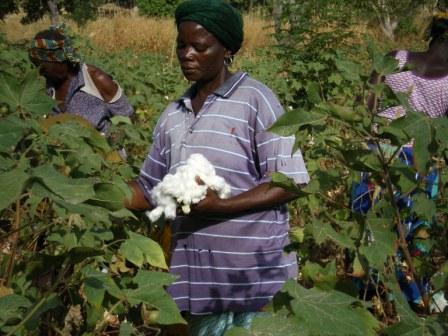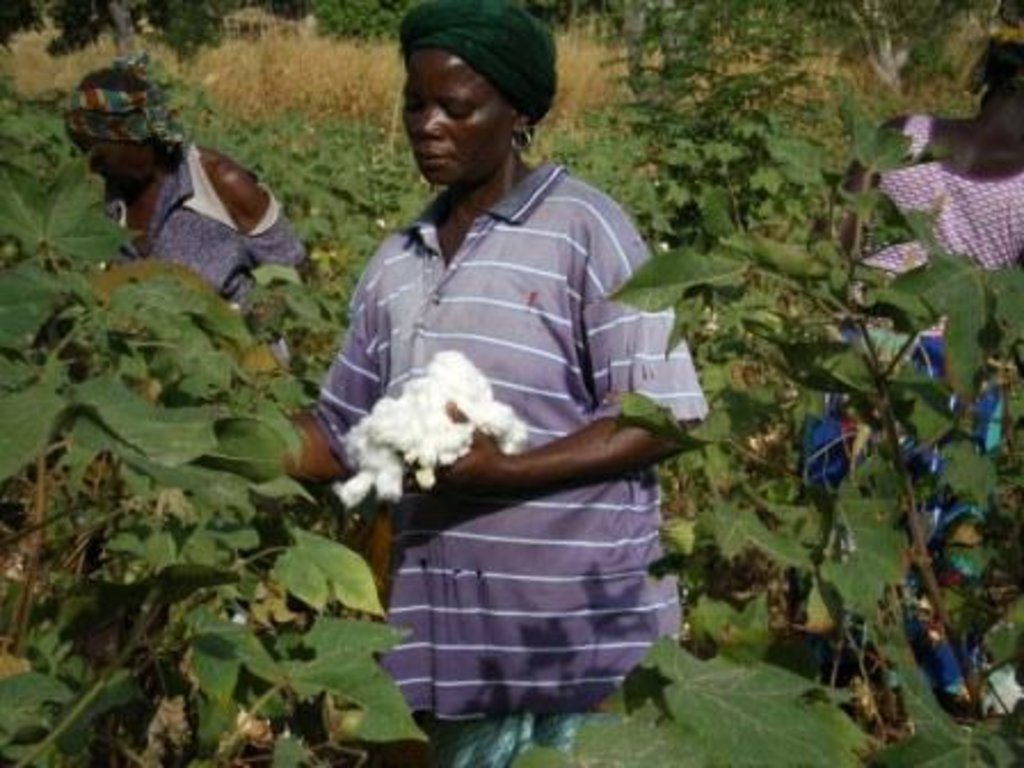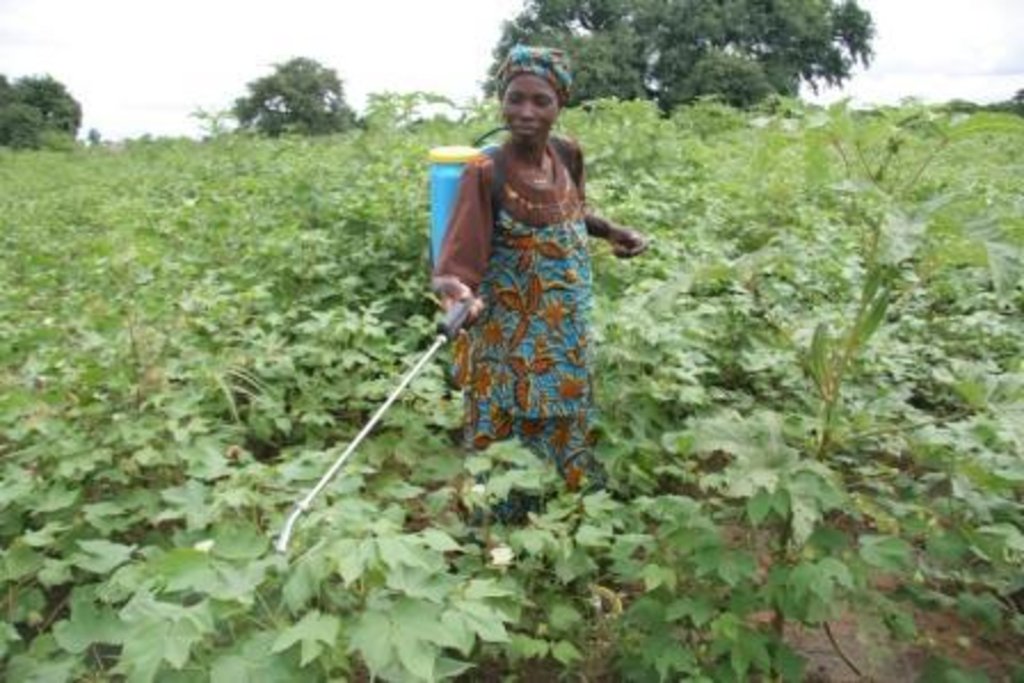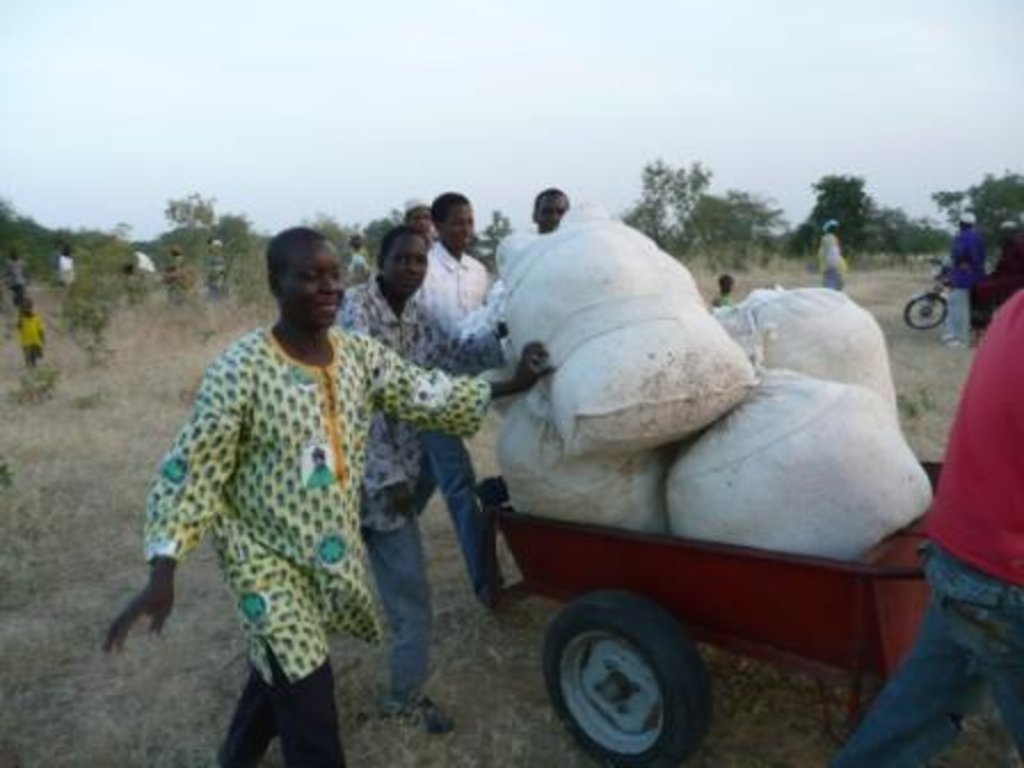Organic cotton [บูร์กินาฟาโซ]
- ผู้สร้างสรรค์:
- การอัพเดท:
- ผู้รวบรวม: Unknown User
- ผู้เรียบเรียง: –
- ผู้ตรวจสอบ: Fabian Ottiger, Alexandra Gavilano
technologies_957 - บูร์กินาฟาโซ
ดูส่วนย่อย
ขยายทั้งหมด ย่อทั้งหมด1. ข้อมูลทั่วไป
1.2 รายละเอียดที่ติดต่อได้ของผู้รวบรวมและองค์กรที่เกี่ยวข้องในการประเมินและการจัดเตรียมทำเอกสารของเทคโนโลยี
วิทยากรหลัก
ผู้เชี่ยวชาญ SLM:
Lazare Yombi
larzare.yombi@helvetas.org
Helvetas Burkina Faso
บูร์กินาฟาโซ
ผู้เชี่ยวชาญ SLM:
Eyhorn Frank
info@helvetas.org
Helvetas
บูร์กินาฟาโซ
ผู้เชี่ยวชาญ SLM:
Dischl Raphael
info@helvetas.org
Helvetas
บูร์กินาฟาโซ
ชื่อของโครงการซึ่งอำนวยความสะดวกในการทำเอกสารหรือการประเมินเทคโนโลยี (ถ้าเกี่ยวข้อง)
Book project: SLM in Practice - Guidelines and Best Practices for Sub-Saharan Africa (SLM in Practice)ชื่อขององค์กรซึ่งอำนวยความสะดวกในการทำเอกสารหรือการประเมินเทคโนโลยี (ถ้าเกี่ยวข้อง)
HELVETAS (Swiss Intercooperation)1.3 เงื่อนไขการใช้ข้อมูลที่ได้บันทึกผ่านทาง WOCAT
ผู้รวบรวมและวิทยากรหลักยอมรับเงื่อนไขเกี่ยวกับการใช้ข้อมูลที่ถูกบันทึกผ่านทาง WOCAT:
ใช่
2. การอธิบายลักษณะของเทคโนโลยี SLM
2.1 การอธิบายแบบสั้น ๆ ของเทคโนโลยี
คำจำกัดความของเทคโนโลยี:
In the Loba province of Burkina Faso, the production, storage, processing and marketing of organic cotton has been promoted since 2004 by Helvetas.
2.2 การอธิบายแบบละเอียดของเทคโนโลยี
คำอธิบาย:
Organic cotton production adheres to the principles and standards of organic farming. Any application of synthetic fertilizers and pesticides and the use of genetically modified varieties are forbidden. Organic cotton relies on a combination of different measures: (1) the use of organic fertilizers (manure or compost) and recycling of organic matter; (2) Crop rotation and/or intercropping; (3) Careful selection of varieties adapted to local conditions (climate, soil, pests and diseases); (4) Biological pest management (in combination with careful monitoring of crops); (5) Clear separation of organic and conventional cropland, e.g. by growing border crops (to avoid contact with chemical substances through spray drift or surface runoff); and (6) Soil and water conservation measures. Timely crop management (e.g. weeding) is very important. In Loba rotations crops include sesame (a cash crop), cereals and legumes (food crops), while intercrops include leguminous green manure and trap plants. The best adapted cotton variety is FK-37. Bio-pesticides are produced based on neem seeds (Azadirachta indica). The measures listed above help to improve soil fertility, reduce production costs (and thus financial risk) and avoid the negative effects of conventional farming: declining yields, resistance to pests and diseases, health hazards and environmental problems caused through the use of chemicals. By relying on inputs available/produced on the farm and by getting a better price for certified organic products, profitability of the farm is improved in the long run despite of lower productivity compared to conventional or genetically modified (GM) cotton. Farms need to complete a 3-year conversion period to change their production system from conventional to organic. Farmers have to maintain records and documents for periodic inspection and certification (Internal control system).
2.3 รูปภาพของเทคโนโลยี
2.5 ประเทศภูมิภาค หรือสถานที่ตั้งที่เทคโนโลยีได้นำไปใช้และได้รับการครอบคลุมโดยการประเมินนี้
ประเทศ:
บูร์กินาฟาโซ
ภูมิภาค/รัฐ/จังหวัด:
Ioba province
ข้อมูลจำเพาะเพิ่มเติมของสถานที่ตั้ง :
Dano
2.6 วันที่การดำเนินการ
ถ้าไม่รู้ปีที่แน่นอน ให้ระบุวันที่โดยประมาณ:
- น้อยกว่า 10 ปี (ไม่นานนี้)
2.7 คำแนะนำของเทคโนโลยี
ให้ระบุว่าเทคโนโลยีถูกแนะนำเข้ามาอย่างไร:
- ทางโครงการหรือจากภายนอก
3. การจัดประเภทของเทคโนโลยี SLM
3.1 วัตถุประสงค์หลักของเทคโนโลยี
- อนุรักษ์ระบบนิเวศน์
- สร้างผลกระทบทางด้านเศรษฐกิจที่เป็นประโยชน์
- สร้างผลกระทบทางด้านสังคมที่เป็นประโยชน์
3.2 ประเภทของการใช้ที่ดินในปัจจุบันที่ได้นำเทคโนโลยีไปใช้

พื้นที่ปลูกพืช
- การปลูกพืชล้มลุกอายุปีเดียว
- การปลูกพืชยืนต้นที่ไม่มีเนื้อไม้
พืชหลัก (พืชเศรษฐกิจและพืชอาหาร):
Major food crop: Cereals, legumes and root crops for subsistence
Major cash crop: Cotton
แสดงความคิดเห็น:
Major land use problems (land users’ perception): Fertility decline and reduced OM content; Biodiversity decline
3.3 ข้อมูลเพิ่มเติมเกี่ยวกับการใช้ที่ดิน
การใช้น้ำของที่ดินที่มีการใช้เทคโนโลยีอยู่:
- จากน้ำฝน
3.4 กลุ่ม SLM ที่ตรงกับเทคโนโลยีนี้
- ระบบหมุนเวียน (การปลูกพืชหมุนเวียน การพักดิน การเกษตรแบบไร่เลื่อนลอย)
- การจัดการความอุดมสมบรูณ์ของดินแบบผสมผสาน
- Organic production
3.5 กระจายตัวของเทคโนโลยี
แสดงความคิดเห็น:
around 7'000 farmers
3.6 มาตรการ SLM ที่ประกอบกันเป็นเทคโนโลยี

มาตรการจัดการพืช
- A2: อินทรียวัตถุในดิน/ความอุดมสมบูรณ์ในดิน
แสดงความคิดเห็น:
Main measures: agronomic measures
Type of agronomic measures: mixed cropping / intercropping, legume inter-planting, manure / compost / residues
3.7 รูปแบบหลักของการเสื่อมโทรมของที่ดินที่ได้รับการแก้ไขโดยเทคโนโลยี

การเสื่อมโทรมของดินทางด้านเคมี
- Cn (Fertility decline): ความอุดมสมบูรณ์และปริมาณอินทรียวัตถุในดินถูกทำให้ลดลงไป (ไม่ได้เกิดจากสาเหตุการกัดกร่อน)

การเสื่อมโทรมของดินทางด้านชีวภาพ
- Bs (Quality and species composition): องค์ประกอบหรือความหลากหลายทางคุณภาพและชนิดพันธุ์ลดลง
แสดงความคิดเห็น:
Main type of degradation addressed: Cn: fertility decline and reduced organic matter content, Bs: quality and species composition /diversity decline
3.8 การป้องกัน การลดลง หรือการฟื้นฟูความเสื่อมโทรมของที่ดิน
ระบุเป้าหมายของเทคโนโลยีกับความเสื่อมโทรมของที่ดิน:
- ป้องกันความเสื่อมโทรมของที่ดิน
- ลดความเสื่อมโทรมของดิน
4. ข้อมูลจำเพาะด้านเทคนิค กิจกรรมการนำไปปฏิบัติใช้ ปัจจัยนำเข้า และค่าใช้จ่าย
4.2 ข้อมูลจำเพาะด้านเทคนิคและการอธิบายแบบแปลนทางเทคนิค
Technical knowledge required for field staff / advisors: high
Technical knowledge required for land users: moderate
Main technical functions: improvement of ground cover, increase in organic matter, increase in nutrient availability (supply, recycling,…), promotion of vegetation species and varieties (quality, eg palatable fodder)
Secondary technical functions: improvement of water quality, buffering / filtering water
Mixed cropping / intercropping
Material/ species: intercrops include leguminous green manure and trap plants
Manure / compost / residues
Material/ species: manure or compost
Agronomic measure: bio-pesticides
Material/ species: from Neem seeds (Azadirachta indica)
4.4 กิจกรรมเพื่อการจัดตั้ง
| กิจกรรม | ประเภทของมาตรการ | ช่วงเวลาดำเนินการ | |
|---|---|---|---|
| 1. | Get a knapsack | จัดการพืช | |
| 2. | None | จัดการพืช |
4.5 ค่าใช้จ่ายของปัจจัยนำเข้าที่จำเป็นสำหรับการจัดตั้ง
| ปัจจัยนำเข้า | หน่วย | ปริมาณ | ค่าใช้จ่ายต่อหน่วย | ค่าใช้จ่ายทั้งหมดต่อปัจจัยนำเข้า | %ของค่าใช้จ่ายที่ก่อให้เกิดขึ้นโดยผู้ใช้ที่ดิน | |
|---|---|---|---|---|---|---|
| แรงงาน | Labour | ha | 1.0 | 2.0 | 2.0 | 100.0 |
| อุปกรณ์ | 15-liter-knapsack | ha | 1.0 | 50.0 | 50.0 | 100.0 |
| ค่าใช้จ่ายทั้งหมดของการจัดตั้งเทคโนโลยี | 52.0 | |||||
4.6 การบำรุงรักษาสภาพหรือกิจกรรมที่เกิดขึ้นเป็นประจำ
| กิจกรรม | ประเภทของมาตรการ | ช่วงระยะเวลา/ความถี่ | |
|---|---|---|---|
| 1. | Compost production / Clear crop residues on fields where cotton will be planted, use for mulch or compost production (no burning) | จัดการพืช | |
| 2. | Apply organic manure: 7.5 t/ha / Ploughing (for incorporation of manure, pest and weed control) | จัดการพืช | |
| 3. | Sow cotton and intercrops (such as Hibiscus esculentus – a trap plant for pests; or Mucuna – a green manure plant); Thin out cotton after 10-20 days (1-2 plants per pocket) | จัดการพืช | |
| 4. | Weeding (3 to 4 times: 20/40/70/100days after sowing)/ Pest control (manual collection); Spraying of bio-pesticide (64 liters / ha, based on neem seeds): according to infestation: up to 3 times | จัดการพืช | |
| 5. | Ridging (form furrows and ridges using plough or manually)/ Pre-harvest weeding/ Harvesting/ Cut cotton stems / residues and incorporate into the soil | จัดการพืช |
4.7 ค่าใช้จ่ายของปัจจัยนำเข้าและกิจกรรมที่เกิดขึ้นเป็นประจำที่ต้องการการบำรุงรักษา (ต่อปี)
| ปัจจัยนำเข้า | หน่วย | ปริมาณ | ค่าใช้จ่ายต่อหน่วย | ค่าใช้จ่ายทั้งหมดต่อปัจจัยนำเข้า | %ของค่าใช้จ่ายที่ก่อให้เกิดขึ้นโดยผู้ใช้ที่ดิน | |
|---|---|---|---|---|---|---|
| แรงงาน | Labour | ha | 1.0 | 160.0 | 160.0 | 100.0 |
| อื่น ๆ | Cotton & intercrop seeds, ma | ha | 1.0 | 28.0 | 28.0 | 100.0 |
| ค่าใช้จ่ายทั้งหมดของการบำรุงรักษาสภาพเทคโนโลยี | 188.0 | |||||
แสดงความคิดเห็น:
Machinery/ tools: hoe, plough, wheel-barrow, knapsack
4.8 ปัจจัยสำคัญที่สุดที่มีผลกระทบต่อค่าใช้จ่าย
ปัจจัยสำคัญที่สุดที่มีผลกระทบต่อค่าใช้จ่ายต่างๆ:
Standard equipment (hoe, plough, wheel-barrow) is not included in costs, knapsack is provided by producer’s association (UNPCB) on credit; transport bags are donated. Labour and other inputs for erosion control measures (e.g. stone bunds) are not included in costs. Neem biocide costs US$ 0.7 per liter; organic cotton seeds cost US$ 1.7 per 50 kg.
5. สิ่งแวดล้อมทางธรรมชาติและของมนุษย์
5.1 ภูมิอากาศ
ฝนประจำปี
- < 250 ม.ม.
- 251-500 ม.ม.
- 501-750 ม.ม.
- 751-1,000 ม.ม.
- 1,001-1,500 ม.ม.
- 1,501-2,000 ม.ม.
- 2,001-3,000 ม.ม.
- 3,001-4,000 ม.ม.
- > 4,000 ม.ม.
เขตภูมิอากาศเกษตร
- กึ่งแห้งแล้ง
Thermal climate class: tropics. Tropical, with high rainfall variability
5.2 สภาพภูมิประเทศ
ค่าเฉลี่ยความลาดชัน:
- ราบเรียบ (0-2%)
- ลาดที่ไม่ชัน (3-5%)
- ปานกลาง (6-10%)
- เป็นลูกคลื่น (11-15%)
- เป็นเนิน (16-30%)
- ชัน (31-60%)
- ชันมาก (>60%)
ธรณีสัณฐาน:
- ที่ราบสูง/ที่ราบ
- สันเขา
- ไหล่เขา
- ไหล่เนินเขา
- ตีนเนิน
- หุบเขา
ระดับความสูง:
- 0-100 เมตร
- 101-500 เมตร
- 501-1,000 เมตร
- 1,001-1,500 เมตร
- 1,501-2,000 เมตร
- 2,001-2,500 เมตร
- 2,501-3,000 เมตร
- 3,001-4,000 เมตร
- > 4,000 เมตร
ความคิดเห็นและข้อมูลจำเพาะเพิ่มเติมเรื่องสภาพภูมิประเทศ:
Altitutinal zone: 101-500 m a.s.l. (300-500m)
5.3 ดิน
ค่าเฉลี่ยความลึกของดิน:
- ตื้นมาก (0-20 ซ.ม.)
- ตื้น (21-50 ซ.ม.)
- ลึกปานกลาง (51-80 ซ.ม.)
- ลึก (81-120 ซ.ม.)
- ลึกมาก (>120 ซ.ม.)
เนื้อดิน (ดินชั้นบน):
- หยาบ/เบา (ดินทราย)
- ละเอียด/หนัก (ดินเหนียว)
อินทรียวัตถุในดิน:
- ปานกลาง (1-3%)
(ถ้ามี) ให้แนบคำอธิบายเรื่องดินแบบเต็มหรือระบุข้อมูลที่มีอยู่ เช่น ชนิดของดิน ค่า pH ของดินหรือความเป็นกรดของดิน ความสามารถในการแลกเปลี่ยนประจุบวก ไนโตรเจน ความเค็ม เป็นต้น:
Soil texture (topsoil): Coarse/light (sandy or sandy-clayey texture) and fine/heavy (cotton prefers dry, hot and sunny climate, a minimum of 500 mm of rain distributed over the vegetation period (5 months), deep and heavy clay soils (vertisols) with no risk of water-logging)
Soil fertility: Medium
Soil drainage / infiltration: Medium
5.6 ลักษณะของผู้ใช้ที่ดินที่นำเทคโนโลยีไปปฏิบัติใช้
แนวทางการตลาดของระบบการผลิต:
- ผสม (การเลี้ยงชีพ/ทำการค้า)
เป็นรายบุคคล/ครัวเรือน:
- เป็นรายบุคคล/ครัวเรือน
ระดับของการใช้เครื่องจักรกล:
- งานที่ใช้แรงกาย
- การใช้กำลังจากสัตว์
ระบุลักษณะอื่นๆที่เกี่ยวข้องของผู้ใช้ที่ดิน:
Difference in the involvement of women and men: certain activities carried out in mutual help groups
Population density: 50-100 persons/km2
Market orientation: Mixed (organic products for market; other crops such as cereals, legumes and root crops for subsistence)
5.7 พื้นที่เฉลี่ยของที่ดินที่เป็นเจ้าของหรือเช่าโดยผู้ใช้ที่ดินที่นำเทคโนโลยีไปปฏิบัติใช้
- < 0.5 เฮกตาร์
- 0.5-1 เฮกตาร์
- 1-2 เฮกตาร์
- 2-5 เฮกตาร์
- 5-15 เฮกตาร์
- 15-50 เฮกตาร์
- 50-100 เฮกตาร์
- 100-500 เฮกตาร์
- 500-1,000 เฮกตาร์
- 1,000-10,000 เฮกตาร์
- >10,000 เฮกตาร์
พิจารณาว่าเป็นขนาดเล็ก กลาง หรือขนาดใหญ่ (ซึ่งอ้างอิงถึงบริบทระดับท้องถิ่น):
- ขนาดเล็ก
แสดงความคิดเห็น:
Average cotton production area ca. 1 ha
5.8 กรรมสิทธิ์ในที่ดิน สิทธิในการใช้ที่ดินและสิทธิในการใช้น้ำ
กรรมสิทธิ์ในที่ดิน:
- รัฐ
สิทธิในการใช้ที่ดิน:
- รายบุคคล
แสดงความคิดเห็น:
group (family clans) / state
6. ผลกระทบและสรุปคำบอกกล่าว
6.1 ผลกระทบในพื้นที่ดำเนินการ (On-site) จากการใช้เทคโนโลยี
ผลกระทบทางด้านเศรษฐกิจและสังคม
การผลิต
การเสี่ยงต่อความล้มเหลวในการผลิต
แสดงความคิดเห็น/ระบุ:
Reduced financial risk, less indebtedness for input provision
รายได้และค่าใช้จ่าย
รายได้จากฟาร์ม
แสดงความคิดเห็น/ระบุ:
better price due to organic premium (50% more than for conventional cotton) compensates initial decrease of yields
ผลกระทบทางด้านเศรษฐกิจและสังคมอื่น ๆ
Production costs
แสดงความคิดเห็น/ระบุ:
less expenses for inputs (- 90% compared to conventional cotton), gross margin is 30% higher,
ผลกระทบด้านสังคมวัฒนธรรมอื่น ๆ
สถานการณ์ด้านสุขภาพ
แสดงความคิดเห็น/ระบุ:
enhanced health of humans and livestock: no health risks due to pesticides, diversified and organic food crops
สถาบันของชุมชน
แสดงความคิดเห็น/ระบุ:
enhanced organisation (farmers groups)
income opportunity for women
ผลกระทบด้านนิเวศวิทยา
ดิน
การหมุนเวียนและการเติมของธาตุอาหาร
แสดงความคิดเห็น/ระบุ:
due to organic manure and crop rotation
อินทรียวัตถุในดิน/ต่ำกว่าดินชั้น C
ความหลากหลายทางชีวภาพของพืชและสัตว์
ชนิดพันธุ์ที่ให้ประโยชน์
แสดงความคิดเห็น/ระบุ:
Eco-balance between pests and beneficial insects
ผลกระทบด้านนิเวศวิทยาอื่น ๆ
Soil water holding capacity
Pollution of the environment through toxic chemicals
แสดงความคิดเห็น/ระบุ:
No pollution
6.3 การเผชิญและความตอบสนองของเทคโนโลยีต่อการเปลี่ยนแปลงสภาพภูมิอากาศที่ค่อยเป็นค่อยไป และสภาพรุนแรงของภูมิอากาศ / ภัยพิบัติ (ที่รับรู้ได้โดยผู้ใช้ที่ดิน)
แสดงความคิดเห็น:
Tolerant to climatic extremes due to higher water retention capacity of soils, reduced erosion and crop diversification (reduced risk of total crop failure)
6.4 การวิเคราะห์ค่าใช้จ่ายและผลประโยชน์ที่ได้รับ
ผลประโยชน์ที่ได้รับเปรียบเทียบกับค่าใช้จ่ายในการจัดตั้งเป็นอย่างไร (จากมุมมองของผู้ใช้ที่ดิน)
ผลตอบแทนระยะสั้น:
ด้านลบ
ผลตอบแทนระยะยาว:
ด้านบวกเล็กน้อย
ผลประโยชน์ที่ได้รับเปรียบเทียบกับค่าใช้จ่ายในการบำรุงรักษาหรือต้นทุนที่เกิดขึ้นซ้ำอีก เป็นอย่างไร (จากมุมมองของผู้ใช้ที่ดิน)
ผลตอบแทนระยะสั้น:
ด้านบวก
ผลตอบแทนระยะยาว:
ด้านบวกอย่างมาก
แสดงความคิดเห็น:
Establishment costs are higher than revenues due to investments & initial decrease in yield (conversion period). On the long term, advanced farmers can achieve same or even higher yields than conventional cotton systems
6.5 การปรับตัวของเทคโนโลยี
จากทั้งหมดที่ได้รับเทคโนโลยีเข้ามามีจำนวนเท่าใดที่ทำแบบทันที โดยไม่ได้รับการจูงใจด้านวัสดุหรือการเงินใด ๆ:
- 0-10%
แสดงความคิดเห็น:
100% of land user families have adopted the Technology with external material support
Comments on adoption trend: The proportion of organic cotton is growing. Cotton is the top export product in Burkina Faso and other West-African countries (50-60 % of export revenues). The proportion of organic cotton is growing. Actually 1% is produced organically. Around 7,000 farmers are producing organic cotton in Burkina Faso, of whom 28% are women.
6.7 จุดแข็ง / ข้อได้เปรียบ / โอกาสของเทคโนโลยี
| จุดแข็ง / ข้อได้เปรียบ / โอกาสในทัศนคติของผู้รวบรวมหรือวิทยากรหลัก |
|---|
| This technology helps to improve soil fertility, reduce production costs (and thus financial risk) and avoid the negative effects of conventional farming: declining yields, resistance to pests and diseases, health hazards and environmental problems caused through the use of chemicals |
6.8 จุดอ่อน / ข้อเสียเปรียบ / ความเสี่ยงของเทคโนโลยีและวิธีการแก้ไข
| จุดอ่อน / ข้อเสียเปรียบ / ความเสี่ยงในทัศนคติของผู้ใช้ที่ดิน | มีวิธีการแก้ไขได้อย่างไร |
|---|---|
| Lack of water | establish water retention structures |
| จุดอ่อน / ข้อเสียเปรียบ / ความเสี่ยงในทัศนคติของผู้รวบรวมหรือวิทยากรหลัก | มีวิธีการแก้ไขได้อย่างไร |
|---|---|
| Coexistence of organic and GMO cotton resulting in high risk of contamination | intensify training of farmers; set up a coordination platform between organic and GMO farms; GMO communication plan; establish a sampling & testing system |
| Insufficient application of manure / compost | training on compost production; promote supply of organic manure (e.g. through SMEs specialized in compost production). |
| Large distance to cotton fields (resulting in high transportation costs) due to interfering of browsing livestock close to village | hay-making and corralling of livestock. |
| Lack of land, land ownership and land security | promote land leasing; resolve tenure problem on political level. |
| Lack of equipment (e.g. plough) | Develop and maintain access to credits for small-scale farmers. |
7. การอ้างอิงและการเชื่อมต่อ
7.2 การอ้างอิงถึงสิ่งตีพิมพ์
หัวข้อ, ผู้เขียน, ปี, หมายเลข ISBN:
Helvetas. 2008. Guide de production - Un manuel de reference (Authors: Ouedraogo A, Yombi L, Doumbia S, Eyhorn F, Dischl R)
หัวข้อ, ผู้เขียน, ปี, หมายเลข ISBN:
Eyhorn F., S.G. Ratter, M. Ramakrishnan. 2005. Organic Cotton Crop Guide – A Manual for Practitioners in the Tropics; Research Institute of Organic Agriculture FiBL, Frick, Switzerland
ลิงก์และโมดูล
ขยายทั้งหมด ย่อทั้งหมดลิงก์
ไม่มีลิงก์
โมดูล
ไม่มีโมดูล







